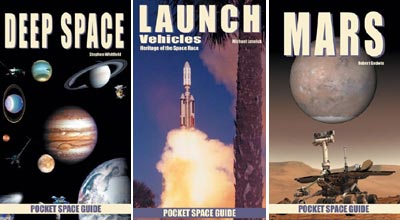|
|
Review: pocket guides to space
by Jeff Foust
Monday, June 5, 2006
Deep Space
by Stephen Whitfield
Apogee Books, 2006
softcover, 96 pages, illus.
ISBN 1-894959-29-9
US$9.95/C$12.95
Launch Vehicles: Heritage of the Space Race
by Michael Lennick
Apogee Books, 2006
softcover, 96 pages, illus.
ISBN 1-894959-28-0
US$9.95/C$12.95
Mars
by Robert Godwin
Apogee Books, 2006
softcover, 96 pages, illus.
ISBN 1-894959-26-4
US$9.95/C$12.95
While books come out in a vast array of sizes, most people are accustomed to seeing books in a fairly standard range of hardcover and softcover sizes. Anything bigger, like the oversized coffee-table books filled with full-color images, or smaller, stands out in comparison. That’s the case with the new “Pocket Space Guide” line of books by Apogee Books. These small books live up to their name, comfortably fitting into a shirt or pants pocket. Their small size and short length offer readers an oh-so-brief introduction, but, understandably, little depth, to an array of space topics.
The three books reviewed here—Deep Space, Launch Vehicles, and Mars—all follow the same formula. The first half of these 96-page books is devoted to text and some basic illustrations and tables, providing a basic introduction to the topic of the book. The second half features full-color pictures and captions about the same topic. In this streamlined format there’s no table of contents and no index, although given the brevity of these books it should be easy for the reader to find what they might be looking for without them.
| The goal of the Pocket Space Guides is to provide “the space aficionado with a series of books covering the entire gamut of space exploration in a user friendly format.” However, given the limitations imposed by the physical size of these books, it’s unlikely that any knowledgeable “aficionado” will learn much from these books. |
While the formula might be the same for all three, the implementation varies. Deep Space offers a hodgepodge of information about the solar system and the universe, and the spacecraft missions devoted to their study; the book is illustrated with a familiar set of images of the planets, the universe, and spacecraft. Launch Vehicles provides a historical essay on the development of launch vehicles, but curiously stops with the Saturn 5: there’s no mention of the space shuttle or other vehicles that have been developed in the last few decades. (The second half of the book does include images of newer launch vehicles; however, one caption identifies the Proton as the vehicle “keeping the International Space Station program alive” while the shuttle is grounded, a credit that belongs instead to the Soyuz.) Mars has the most comprehensive essay of the three, providing a history of our study of the Red Planet from 19th century speculation about life there to the missions of the Mars Exploration Rovers and ESA’s Mars Express orbiter. However, there’s no room to discuss the planned and potential future exploration of the planet by robots or humans.
The goal of the Pocket Space Guides, according to the publisher, is to provide “the space aficionado with a series of books covering the entire gamut of space exploration in a user friendly format.” However, given the limitations imposed by the physical size of these books, it’s unlikely that any knowledgeable “aficionado” will learn much from these books. For the beginner space enthusiast, though, looking for an introduction to these topics, these guides might be the gateway for further exploration in bigger books.
Jeff Foust (jeff@thespacereview.com) is the editor and publisher of The Space Review. He also operates the Spacetoday.net web site and the Space Politics and Personal Spaceflight weblogs. Views and opinions expressed in this article are those of the author alone, and do not represent the official positions of any organization or company, including the Futron Corporation, the author’s employer.
|
|
